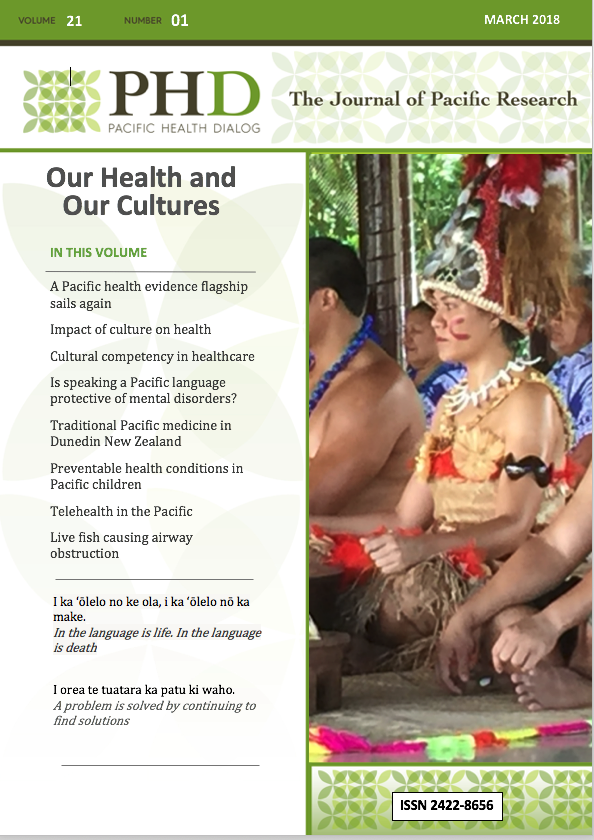Is Pacific language ability protective of prevalence of mental disorders among Pacific peoples in New Zealand?
Main Article Content
Keywords
Language, Mental Health, Pacific, Culture
Abstract
Aims: To explore associations between experiences of mental illness, migration status and languages spoken among Pacific adults living in NZ.
Methods: SURVEY FREQ and SURVEY LOGISTIC procedures in SAS were applied to data from Te Rau Hinengaro: The New Zealand (NZ) Mental Health Survey, a survey of 12,992 New Zealand adults aged 16 and over in 2003/2004. Pacific people were over sampled and this paper focuses on the 2374 Pacific participants but includes, for comparison, 8160 non-Maori-non-Pacific (NMNP) participants.
Results: Pacific migrant respondents had the lowest prevalence of mental disorders compared to other Pacific peoples. However, Pacific immigrants were also less likely to use mental health services, suggesting an increased likelihood of experiencing barriers to available mental health care. Those who were born in NZ and who were proficient in a Pacific language had the lowest levels of common mental disorders, suggesting a protective effect for the NZ-born population. Additionally, access to mental health services was similar between NZ-born people who spoke a Pacific language and those who did not.
Conclusions: We conclude that, given the association between Pacific language and reduced mental disorder, there may be a positive role for Pacific language promotion in efforts to reduce the prevalence of mental health disorder among Pacific communities in NZ.
References
2. Foliaki S, J. K, D. S, et al. Twelve-month and lifetime prevalences of mental disorders and treatment contact among Pacific people in Te Rau Hinengaro: the New Zealand Mental Health Epidemiology Survey. In: Oakley Browne MA, Wells JE, Scott KM, eds. Te Rau Hinengaro: the New Zealand Mental Health Survey. Wellington: Ministry of Health 2006. https://www.health.govt.nz/system/files/documents/publications/mental-health-survey.pdf
3. Foliaki SA, Kokaua J, Schaaf D, et al. Twelve-month and lifetime prevalences of mental disorders and treatment contact among Pacific people in Te Rau Hinengaro: The New Zealand Mental Health Survey. Australian and New Zealand Journal of Psychiatry 2006;40(10):924-34. http://onlinelibrary.wiley.com/doi/10.1111/j.1440-1614.2006.01912.x/full
4. Ministry of Health. Te Orau Ora: Pacific Mental Health Profile. Wellington, New Zealand: Ministry of Health, 2005. https://www.mentalhealth.org.nz/assets/ResourceFinder/2005-pacificmentalhealthprofile.pdf
5. Ministry for Pacific Peoples. Contempory Pacific Status report. Wellington, New Zealand: Ministry for Pacific Peoples, 2016. http://www.mpia.govt.nz/assets/Uploads/Contemporary-Report-Web.pdf
6. Kokaua J, Schaaf D, Wells JE, et al. Twelve-month prevalence, severity, and treatment contact of mental disorders in New Zealand born and migrant Pacific participants in Te Rau Hinengaro: The New Zealand Mental Health Survey. Pacific health dialog 2009;15(1):9-1. https://www.ncbi.nlm.nih.gov/pubmed/19585730
7. Samu KS, Suaalii-Sauni T. Exploring the 'cultural'in cultural competencies in Pacific mental health. Pacific Health Dialog 2009;15(1):120-30. https://www.tepou.co.nz/uploads/files/resource-assets/exploring-the-cultural-in-cultural-competencies-in-pacific-mental-health.pdf
8. Suaalii-Sauni T, Wheeler A, Saafi E, et al. Exploration of Pacific perspectives of Pacific models of mental health service delivery in New Zealand. Pacific Health Dialog 2009;15(1):18-27. https://www.tepou.co.nz/uploads/files/resource-assets/exploration-of-Pacific-perspectives-of-Pacific-models-of-mental-heath-service-delivery-in-New-Zealand.pdf
9. Mila-Schaaf K, Hudson M. The interface between cultural understandings: Negotiating new spaces for Pacific mental health. Pacific Health Dialog 2009;15(1):113-19. https://www.tepou.co.nz/uploads/files/resource-assets/the-interface-between-cultural-understandings-negotiating-new-spaces-for-pacific-mental-health.pdf
10. Borrows J, Williams M, Schluter P, et al. Pacific Islands Families Study: The association of infant health risk indicators and acculturation of Pacific Island mothers living in New Zealand. Journal of Cross-Cultural Psychology 2011;42(5):699-724. https://studydaddy.com/attachment/35964/journal_of_cross-cultural_psychology-2011-borrows-699-724.pdf
11. Manuela S, Sibley CG. The Pacific Identity and Wellbeing Scale (PIWBS): A culturally-appropriate self-report measure for Pacific peoples in New Zealand. Social indicators research 2013;112(1):83-103. https://link.springer.com/article/10.1007/s11205-012-0041-9
12. Manuela S, Sibley CG. Exploring the hierarchical structure of Pacific identity and wellbeing. Social indicators research 2014;118(3):969-85. https://www.researchgate.net/profile/Chris_Sibley/publication/258164767_Exploring_the_Hierarchical_Structure_of_Pacific_Identity_and_Wellbeing/links/5555035308ae980ca60ad680.pdf
13. Starks D, Taumoefolau M, Bell A, et al. Language as a marker of ethnic identity in New Zealand's Pasifika communities. Proceedings of the 4th International Symposium on Bilingualism, 2005:2189-96. http://www.lingref.com/isb/4/171ISB4.PDF
14. Starks D. The changing roles of language and identity in the New Zealand Niuean community: Findings from the Pasifika Languages of Manukau Project. International Journal of Bilingual Education and Bilingualism 2006;9(3):374-91. http://www.tandfonline.com/doi/abs/10.1080/13670050608668655
15. Hunkin GA. "To Let Die" The state of the Samoan language in New Zealand. AlterNative: An International Journal of Indigenous Peoples 2012;8(2):203-14. http://journals.sagepub.com/doi/abs/10.1177/117718011200800208
16. McCaffery J, McFall-McCaffery JT. O Tatou ? Aga'I I Fea?/'Oku Tau ? Ki Fe?/Where Are We Heading? Pacific languages in Aotearoa/New Zealand. AlterNative: An International Journal of Indigenous Peoples 2010;6(2):86-121. http://journals.sagepub.com/doi/abs/10.1177/117718011000600203
17. Tima MTiT. Youth participation: does it have a place in the Samoan traditional church? Exploring youth perceptions of the EFKS in South Auckland. Auckland University of Technology, 2013. http://aut.researchgateway.ac.nz/bitstream/handle/10292/7721/TimaT.pdf?sequence=3&isAllowed=y
18. Oakley Browne MA, Wells EJ, Scott KM. Te Rau Hinengaro: The NZ Mental Health Survey 2003/4. Wellington, New Zealand: Ministry of Health, 2006. https://www.health.govt.nz/system/files/documents/publications/mental-health-survey.pdf
19. World Health Organization. The World Mental Health Composite International Diagnostic Interview. 2015, 2017.
20. Statistics New Zealand. Census-major ethnic groups in New Zealand. Wellington, New Zealand 2013. http://www.stats.govt.nz/Census/2013-census/profile-and-summary-reports/infographic-culture-identity.aspx
21. SAS [program]. North Carolina: SAS Institute Inc, 1999.


